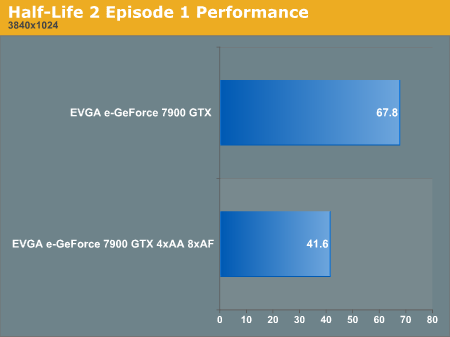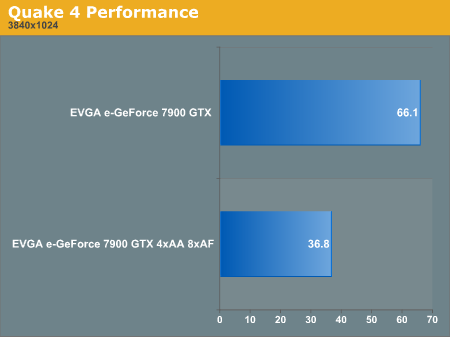TripleHead2Go: The Latest External Multi-Display Upgrade from Matrox
by Josh Venning on July 31, 2006 12:05 AM EST- Posted in
- GPUs
Performance
The fact that the TripleHead2Go allows for wider resolutions naturally results in higher performance demands on your graphics hardware. We wanted to get a basic idea of how well our system was able to run benchmarks in both Quake 4 and Half-Life 2: Episode One at the highest resolution possible (3840x1024). As we mentioned before, ATI hardware isn't able to achieve this resolution, so instead we tested one of the most powerful NVIDIA cards we had, the EVGA e-GeForce 7900 GTX (Factory overclocked to 690MHz/1.76GHz) with and without AA.
Here are the specifications of the system we used, along with the benchmark results for a couple games:


Considering the sheer power of the EVGA 7900 GTX, the results we see here are interesting. While this card runs these tests fairly easily, less powerful cards will definitely have their limits pushed with this resolution, especially with AA enabled. This means a graphics upgrade might be required, which in turns means higher cost for the potential buyer. As of right now, ATI users won't be able to run games at the highest resolution (3840x1024) due to an apparent driver issue, but hopefully this as well as the Crossfire issue will be fixed in the near future. Until then, it looks as though NVIDIA users will benefit most from the Matrox TripleHead2Go.
Power Consumption
Besides the raw GPU power required to run this device with games, we were also interested to find out what kind of power draw we could expect from something like the TripleHead2Go. We measured the overall wattage of the device at the wall from its external power connection, which looks very similar to a laptop power cord. Also, we took power readings while the system was idle at the highest resolution (with only windows running 3840x1024 across three monitors) and under load (running a game at the same resolution). Here are the results:
We can see that the TripleHead2Go draws very little power, which is a plus, and the fact that it has an external power connection means that you won't have to worry about any extra strain on your computer's power supply. That does mean you will need one more power socket near the computer when using the TH2G, but since a power strip will likely be needed to drive three displays plus the PC already that shouldn't be a problem.
The fact that the TripleHead2Go allows for wider resolutions naturally results in higher performance demands on your graphics hardware. We wanted to get a basic idea of how well our system was able to run benchmarks in both Quake 4 and Half-Life 2: Episode One at the highest resolution possible (3840x1024). As we mentioned before, ATI hardware isn't able to achieve this resolution, so instead we tested one of the most powerful NVIDIA cards we had, the EVGA e-GeForce 7900 GTX (Factory overclocked to 690MHz/1.76GHz) with and without AA.
Here are the specifications of the system we used, along with the benchmark results for a couple games:
AMD FX-57
2GB DDR 400 RAM
NVIDIA GeForce 7900GTX
Seagate 7200.7 Harddrive
OCZ 700W PSU


Considering the sheer power of the EVGA 7900 GTX, the results we see here are interesting. While this card runs these tests fairly easily, less powerful cards will definitely have their limits pushed with this resolution, especially with AA enabled. This means a graphics upgrade might be required, which in turns means higher cost for the potential buyer. As of right now, ATI users won't be able to run games at the highest resolution (3840x1024) due to an apparent driver issue, but hopefully this as well as the Crossfire issue will be fixed in the near future. Until then, it looks as though NVIDIA users will benefit most from the Matrox TripleHead2Go.
Power Consumption
Besides the raw GPU power required to run this device with games, we were also interested to find out what kind of power draw we could expect from something like the TripleHead2Go. We measured the overall wattage of the device at the wall from its external power connection, which looks very similar to a laptop power cord. Also, we took power readings while the system was idle at the highest resolution (with only windows running 3840x1024 across three monitors) and under load (running a game at the same resolution). Here are the results:
| Power Draw | |
| Idle | 4W |
| Load | 10W |
We can see that the TripleHead2Go draws very little power, which is a plus, and the fact that it has an external power connection means that you won't have to worry about any extra strain on your computer's power supply. That does mean you will need one more power socket near the computer when using the TH2G, but since a power strip will likely be needed to drive three displays plus the PC already that shouldn't be a problem.










23 Comments
View All Comments
blinkin2000 - Wednesday, August 2, 2006 - link
All you need is better nvidia drivers, SLI drivers that support multiple monitors. Currently they do not. I have one 7900gtx and i can span a lot of games across my two 20" lcds @3200x1200. but if SLI supported multiple monitors i would buy a third monitor and the display would be 4800x1200. Then Quad-SLI would be something to think about.If nvidia would make better SLI drivers then matrox's "niche" would disappear.
R3MF - Tuesday, August 1, 2006 - link
3072x1280 on a digital pickup would rock.araczynski - Monday, July 31, 2006 - link
nice, but until projectors come down in price and i can afford to have 3, i'll take mysxga projector over 3 19" monitors anyday.
i'm using a 24"widescreen, 19" widescreen, and 18" regular monitors on my computer at work, and i must say its very nice programming on that kind of a setup, so this device has a lot of potential aside from gaming, especially since programming doesn't exactly take serious graphics power ;).
Avalon - Monday, July 31, 2006 - link
Interesting product. It wouldn't be that bad to feasibly set up such a system, since ideally you're going to want three 19" LCDs, which can be had for under $200 a pop. The price after adding in the TH2G will probably come in close to some who buy a 2407FPW.The only thing that does stink is that half inch of space between the monitors. It does sound like a tempting DIY experiment to try and remedy that gap.
JNo - Monday, July 31, 2006 - link
but a step in the right direction admittedly...Paladin165 - Monday, July 31, 2006 - link
What I can't figure out is why some LCD manufacturer hasn't come out with LCD moniters that have the ability to sort of "snap" together, creating a more-or-less unified display. Do they really need the half-inch of plastic around the edges? Could this maybe be a DIY project to cut off the edges of these displays and get the viewable portions closer together?ksherman - Tuesday, August 1, 2006 - link
ive akways wondered the same thing... I remember the guy that made a grid of displays (cant remember how many, i think it was 5x5 or something) and it looked dumb with the lines inbetween each monitorJNo - Monday, July 31, 2006 - link
1) works best with nvidia2) no dvi
3) works with sli/crossfire? prob difficult to implement
4) limited resolutions (should support X x 1200 resolutions ideally)
5) few games supported
6) need to be able to hack FOV in other games - could be a pain
7) need 3 similar brand/model monitors ideally (for clean side-by-side setups)
8) again resolution - they were talking of being able to have a widescreen monitor in the middle and 2x 4x3 monitors at the side - that would be awesome but still not implemented
9) power - no cards/setup powerful enough to get good framerates at these huge resolutions
10) expensive
Googer - Monday, July 31, 2006 - link
I am wondering what the benchmarks would be like if the Triple Head to Go was used with a x1900xt or in SLi/Crossfire Modes?Lonyo - Monday, July 31, 2006 - link
"and while the wide resolutions were nice, the split down the middle from the sides of the two monitors pressed together made it all but useless for most types of gaming."With DualHead2Go, can you not hook up one graphics card output to it (and therefore 2 monitors) and then use the other output for a third monitor, creating a triple head setup using both the graphics cards outputs (one being double by the dualhead2go)?